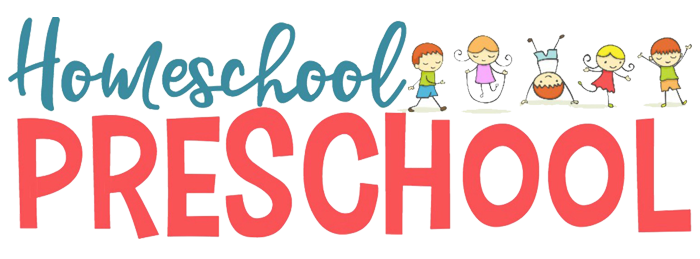Dinosaur Sensory Bin
Welcome to our latest activity – the Dinosaur Sensory Bin! This hands-on, educational experience is not only a delightful journey into the world of dinosaurs, but it also serves as an exciting platform for children to learn while playing.
The sensory bin is filled with a variety of materials and dinosaur-themed toys that stimulate a child’s senses, encourage exploration, and foster their natural curiosity.
Packed with elements of fun and learning, this dinosaur activity for preschool is a fantastic way to engage children in creative play while subtly enhancing their knowledge and understanding.
Let the prehistoric adventure begin!
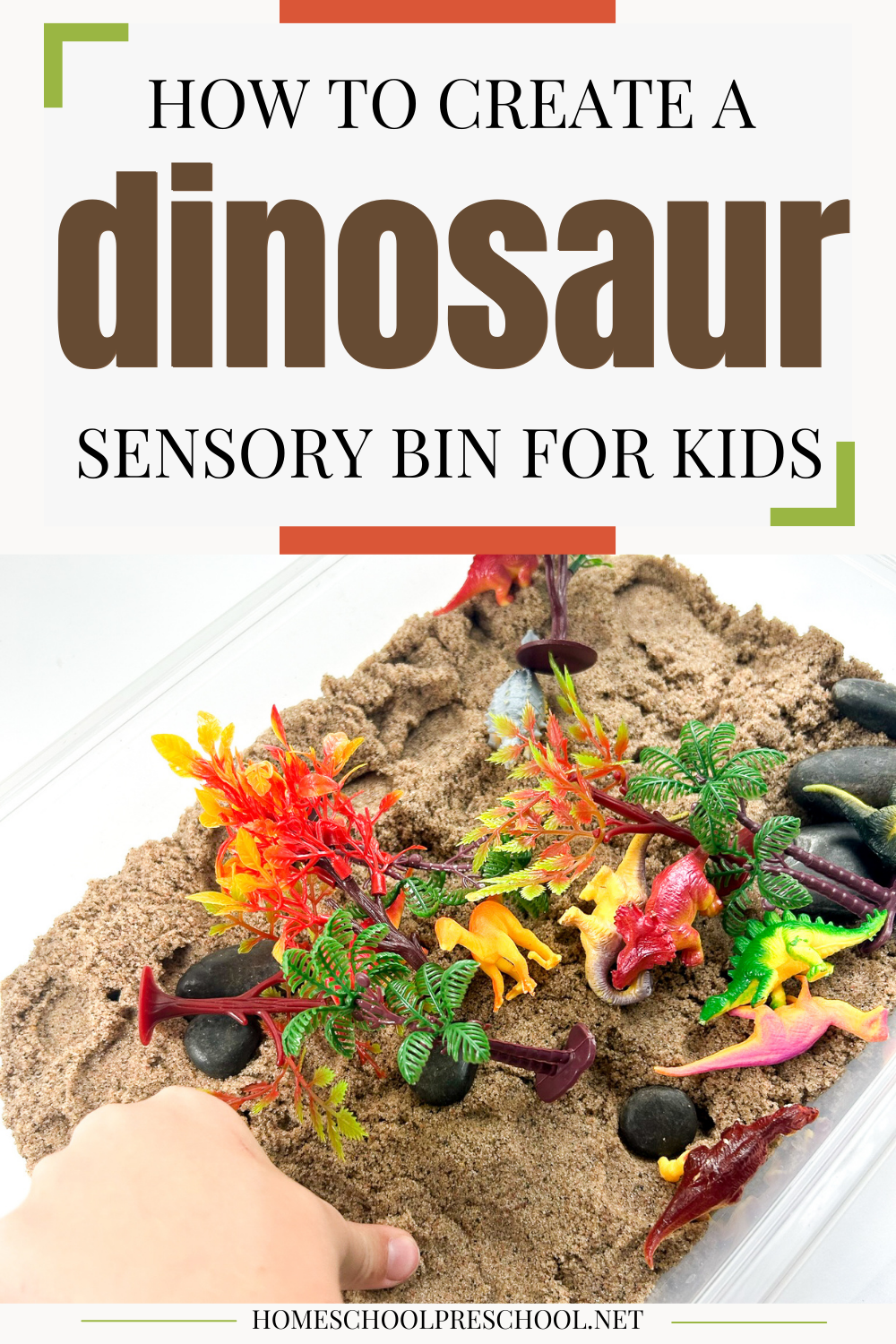
Why are sensory bins important?
The benefits of sensory play are numerous. Using sensory bins in the preschool classroom is a highly effective method of promoting active, exploratory learning. As children delve into these educational treasure troves, they have the opportunity to interact with different textures, shapes, and colors, thus stimulating their senses and enhancing fine motor skills.
It’s not just about hand-eye coordination; sensory bins also nurture cognitive development. As children sift, sort, and maneuver the items in the bin, they spontaneously engage in problem-solving and discovering new concepts.
The dinosaur sensory bin, for instance, serves as an exciting introduction to prehistoric life, while simultaneously fostering imaginative play. Whether it’s dinosaurs, a beach-themed bin, or a bin filled with farm animals, sensory bins are a valuable tool in the preschool classroom for making learning a fun, tactile, and multi-sensory experience.
Preschool Sensory Bins
Now that we’ve delved into the significance of sensory bins, let’s explore some creative sensory bin ideas for your preschool classroom. These ideas are not just entertaining; they are also designed to foster cognitive and sensory development in a fun, engaging manner.
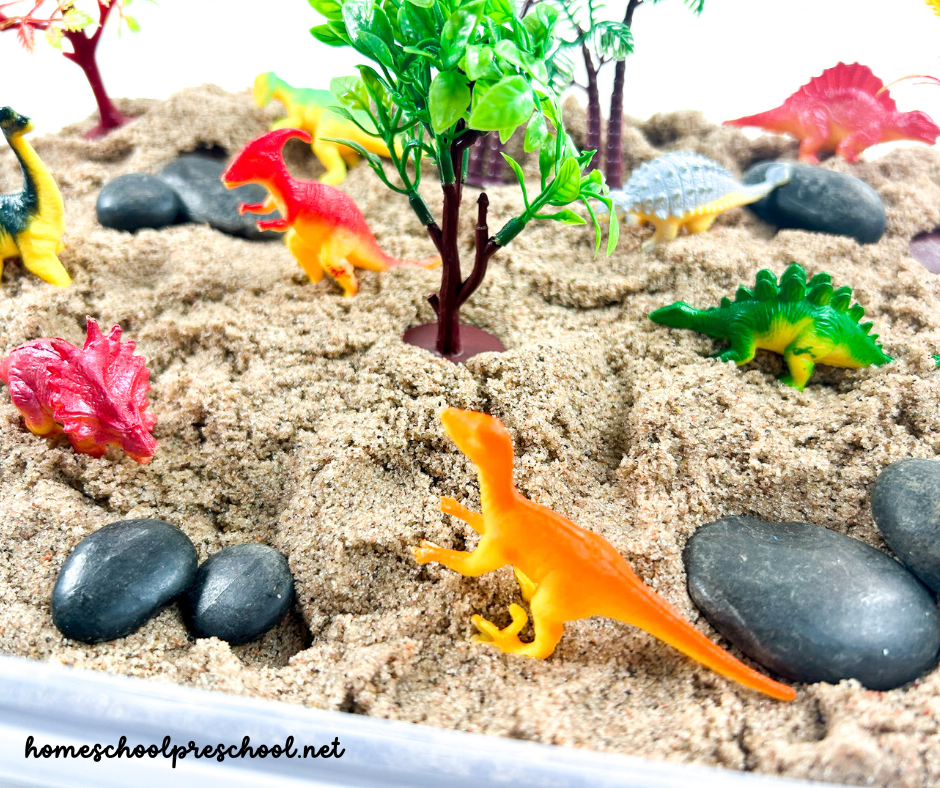
Dinosaur Sensory Bin
As we journey together, we’ll explore the components of this sensory bin and how it helps in fostering a child’s cognitive and sensory development.
What You’ll Need
- sensory bin
- kinetic sand
- dinosaur toys
- plastic trees
- small stones
Setting Up the Sensory Bin
Prepare your workspace: Clear a flat and stable surface to set up your sensory bin. It’s advisable to lay down a mat or old sheet to catch any spills, making cleanup easier later.
Fill the bin with kinetic sand: Pour your kinetic sand into the sensory bin, spreading it evenly across the bottom. This will become the ‘terrain’ of your dinosaur world.
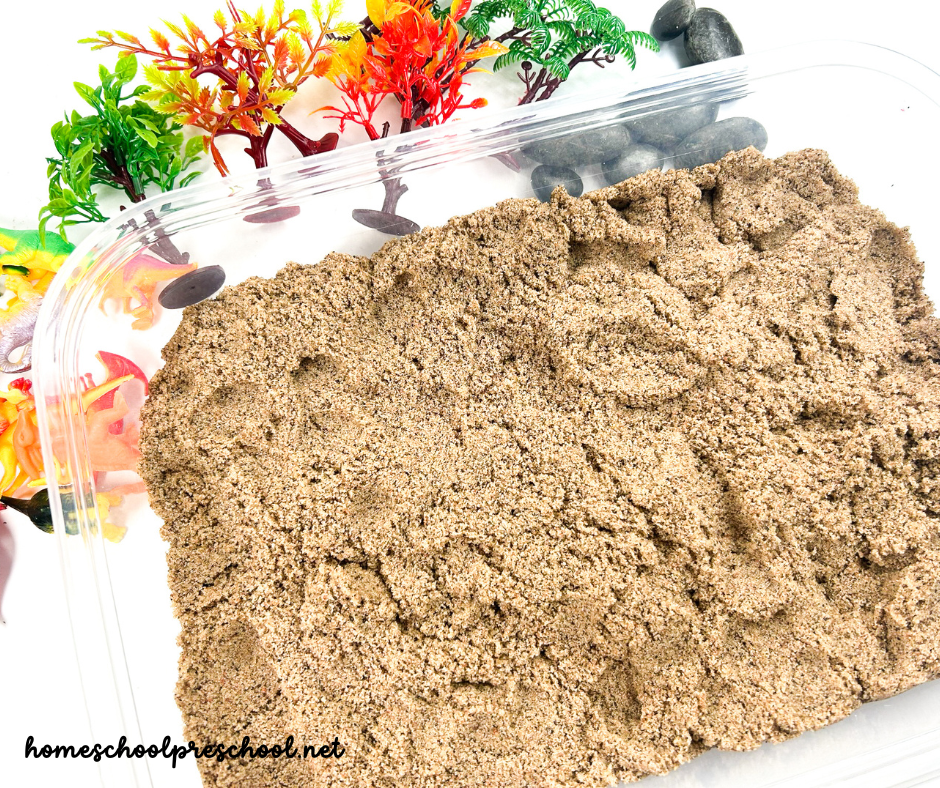
Position the dinosaur toys: Now it’s time to introduce your dinosaur toys. Place them throughout the sand, ensuring there’s enough space between each one for easy play. You can partially bury some dinos, making it a fun discovery activity for the kids.
Add your plastic trees: Scatter your plastic trees throughout the bin to create a more realistic environment. You can position some near the dinosaurs to simulate a natural habitat.
Scatter small stones: Lastly, sprinkle the small stones across the sand. They can act as ‘boulders’ in your prehistoric landscape, providing additional tactile elements for the kids.
And there you have it! Your Dinosaur Sensory Bin is ready for exploration. Remember, the setup is flexible – feel free to add or change elements as you see fit to create an engaging and educational play exploration for your preschoolers.
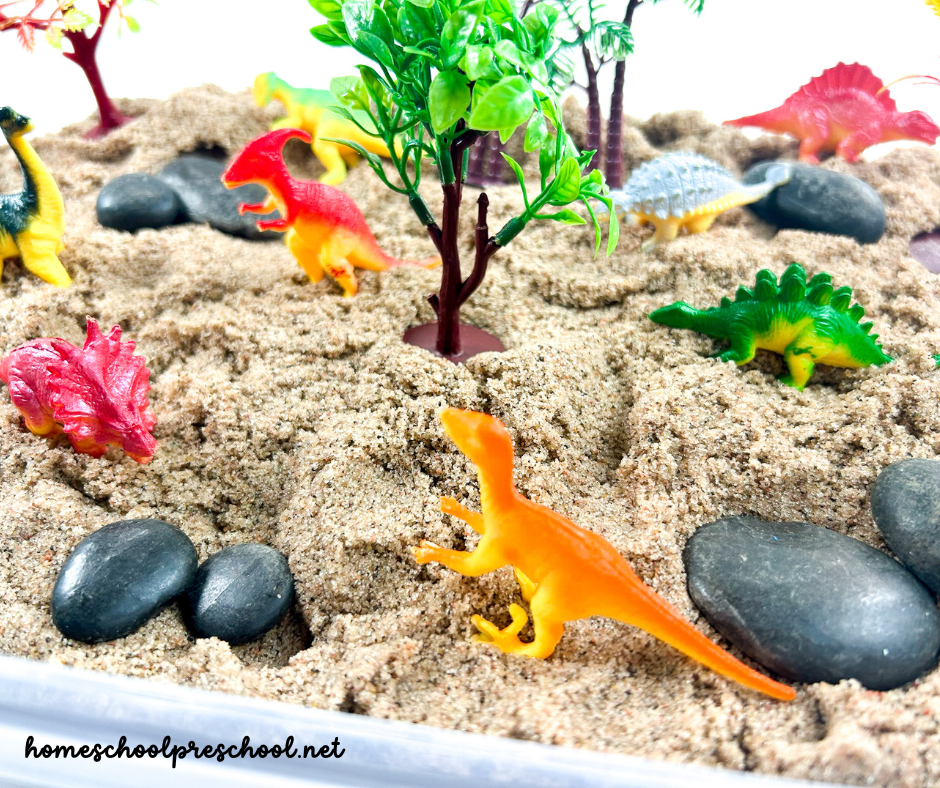
Learning Opportunities
The Dinosaur Sensory Bin presents a multitude of learning opportunities tailored towards enhancing a child’s cognitive and sensory abilities. For starters, it offers an engaging platform for children to practice counting.
With a range of dinosaur toys scattered throughout the bin, children can count the dinosaurs, trees, or stones, thereby cultivating their numerical skills.
The sensory bin also aids in color recognition. By identifying and naming the colors of the dinosaurs, stones, and trees, children can strengthen their understanding of different colors.
Additionally, by categorizing the dinosaurs based on color, they can learn about sorting and grouping, which are fundamental concepts in early math learning.
The activity further fosters problem-solving skills. Children can engage in scenarios where dinosaurs interact with their environment, stimulating imaginative and creative thinking. They can also navigate challenges such as finding partially buried dinosaurs, promoting logical thinking and problem-solving.
Overall, the Dinosaur Sensory Bin, while entertaining, is a tool to build crucial skills in a fun and interactive way.
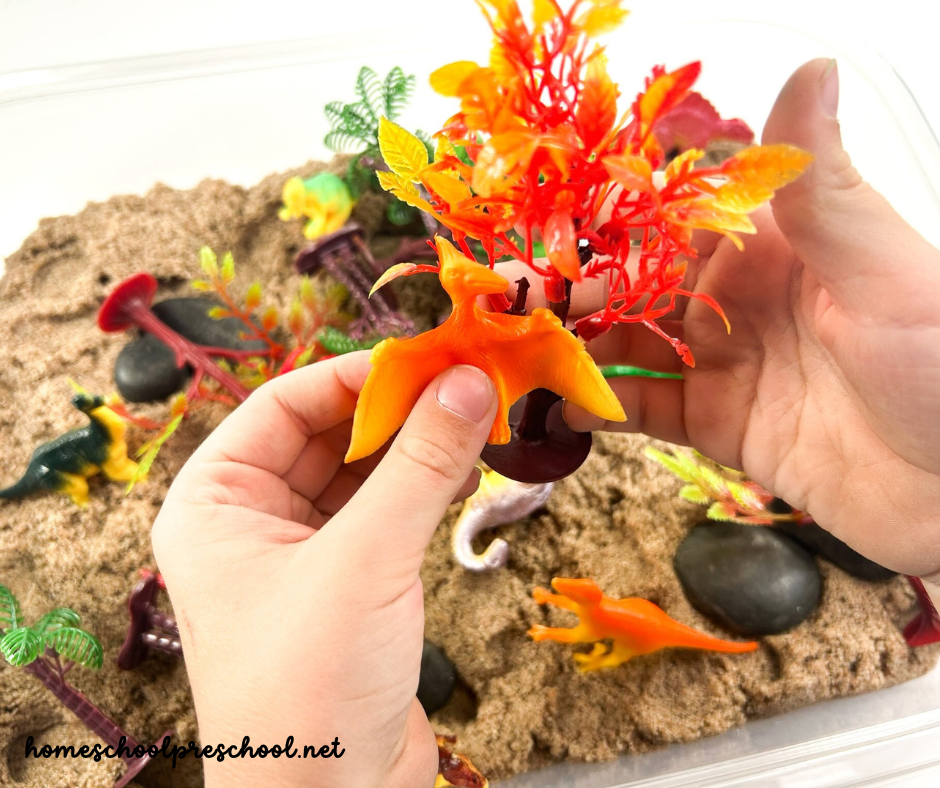
Dinosaur Activities for Preschoolers
In addition to the sensory bin, there are a plethora of dinosaur-themed activities that can further enhance children’s learning and engagement. Here are a few ideas for your preschool classroom:
1. Dinosaur Fossil Making: An activity that combines science and art, making dinosaur fossils from salt dough is a fun and educational task. Children can shape their fossils using dinosaur toys, letting them dry, and then painting them for added effect.
2. Dinosaur Story Time: Use dinosaur-themed children’s books to spark the kids’ imaginations and curiosity about these prehistoric creatures. This also helps in enhancing their listening and comprehension skills.
3. Dinosaur Role Play: Set up a dinosaur-themed corner in the classroom where children can engage in make-believe and role-play, pretending to be dinosaurs or paleontologists. This fosters imaginative play and social skills.
4. Dinosaur Puzzle: Provide dinosaur puzzles that children can work on either individually or in groups. This promotes problem-solving and teamwork skills.
5. Dinosaur Songs and Rhymes: Incorporate songs and rhymes related to dinosaurs into your circle time. This not only makes learning about dinosaurs fun but also improves children’s phonetic and language skills.
Remember, the key to effective learning at this stage is to make it fun and interactive. Making dinosaurs a central theme of various activities can help kids develop a range of skills while fueling their fascination for these incredible creatures.
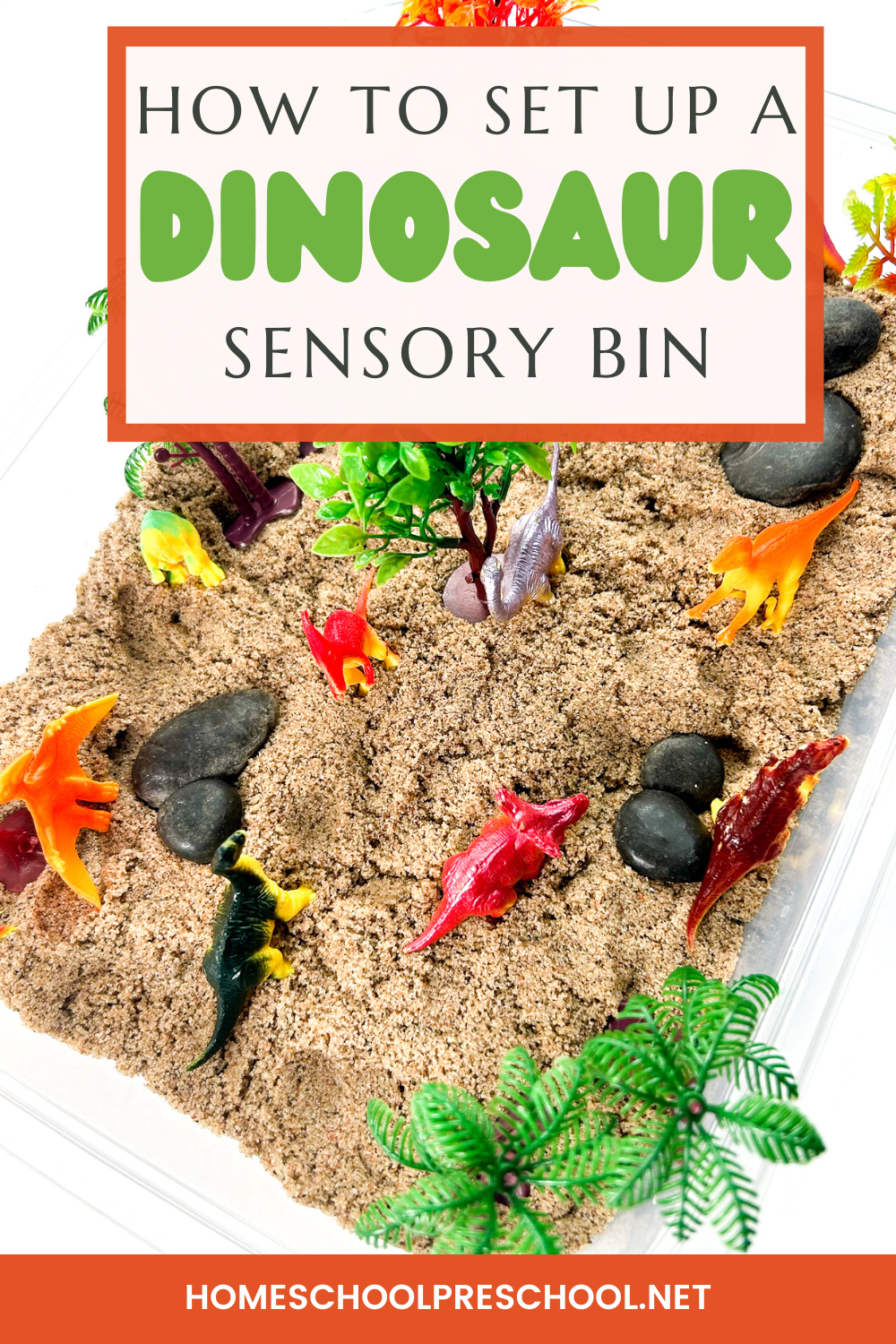
In conclusion, sensory bins, specifically the Dinosaur Sensory Bin, offer a versatile and dynamic platform for children to explore, discover, and learn in an engaging and fun environment. It’s not just about playing with sand and toys, but about enriching a child’s cognitive, sensory, and interactive skills.
Coupled with additional dinosaur-themed activities, preschoolers can delve deeper into the fascinating world of dinosaurs while simultaneously enhancing their developmental skills.
Remember, the goal is to make learning enjoyable and interactive, and what better way to do so than with a hands-on experience in a dinosaur world?
